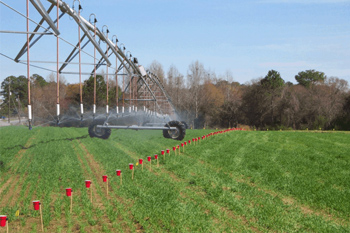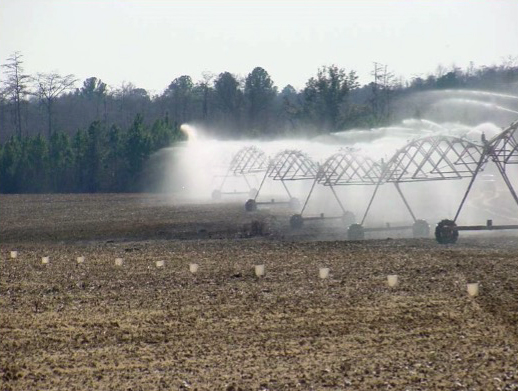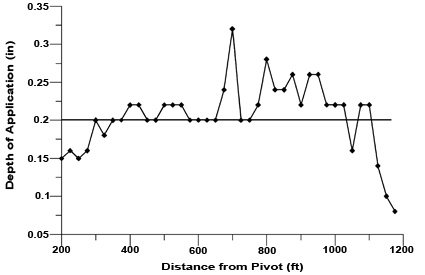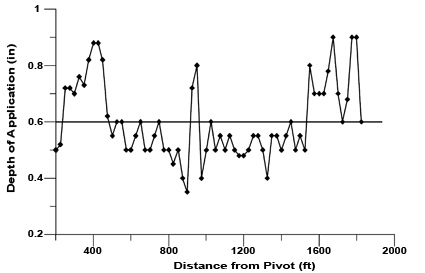 Figure 1. Catch cup layout using 16-oz drink cups as collection devices.
Figure 1. Catch cup layout using 16-oz drink cups as collection devices. Figure 2. Paint cup layout for collection devices.
Figure 2. Paint cup layout for collection devices.With rising cost of irrigation it is increasingly important that irrigation systems apply water uniformly in order to achieve maximum benefit from the water applied. When irrigation systems are used to apply fertilizers and pesticides, application uniformity becomes even more critical. Consequently, it is important for center pivot owners and operators to periodically check the uniformity of their systems.
The uniformity of water application under a center pivot is determined by placing buckets or rain gauges along the length of the pivot, bringing the irrigation system up to a standard operating pressure, and letting the system pass over them (Figure 1). Record the distance from the center of the pivot and the amount of water collected for each bucket or gauge. From this information, a coefficient of uniformity can be calculated. The coefficient of uniformity is usually expressed as a percentage. Interpretation of these values is presented later. Water can be collected by several means, as seen in Figures 1 and 2.
Methods and Formulas
A number of methods/formulas can be used for determining application uniformity. Certain methods are preferred for different types of irrigation systems. For a center pivot irrigation system, the easiest and most widely used method/formula is the Christiansen Uniformity coefficient. The mathematical equation for the Christiansen Uniformity coefficient is:
CU = 100 [1 - (A/B)]
CU is the Christiansen Coefficient; A is the sum of the absolute value of the deviation of the average catch cup value from each individual catch cup data point, and B is the sum of the catch cup observations.
A second method/formula specifically for center pivots is the Heerman and Hein Uniformity coefficient. It is the method recommended by the American Society of Agricultural and Biological Engineers (ANSI/ASAE S436.1). It is very mathematically involved and requires the use of a computer in most cases. There are multiple computer programs available that can do the lengthy and involved calculations for you. You can even use Microsoft Excel, a program on most home computers, to develop your own data analysis.
UGA Extension offers free pivot uniformity evaluations on farms. Contact your local UGA county Extension agent and work with them to get a Mobile Irrigation Lab (MIL) evaluation performed on your farm. If there are multiple pivots and a producer would like to perform tests on his own, UGA Extension can enter the data collected and supply uniformity results.
For a simple “do-it-yourself ” approach to analyzing pivot uniformity, a simple plot of the data will reveal the places along the pivot where “high” or “low” applications have occurred (Figures 3 and 4).
 Figure 3. Plot of uniformity data with minor nozzle problems.
Figure 3. Plot of uniformity data with minor nozzle problems.Figure 3 is an example of a system where only certain sprinklers need attention. The calculated uniformity coefficient was 83% (see table at end of discussion for more explanation of interpreting the uniformity coefficient). While this coefficient is acceptable, it could still be improved by correcting the high application at/near the 700-ft distance and the low application beyond 1,100 ft. When this correction was made, the uniformity coefficient improved to 89%.
 Figure 4. Plot of uniformity data with major nozzle problems.
Figure 4. Plot of uniformity data with major nozzle problems.Figure 4 is an example of a system that needs new nozzles or sprinklers to correct the uniformity problem. The “high” and “low” application amounts are at several locations along the system, making individual sprinkler replacement too involved. The calculated uniformity coefficient for this system was 81%. The recommendation was made to “renozzle” the system since any further change in application would result in a uniformity coefficient below 80%.
Rain gauges, 16-oz drink cups, paint buckets, or other containers of uniform size may be used to perform a uniformity test. If rain gauges are used, the amount collected may be recorded directly in inches. If other containers are used, the volume collected can be determined by pouring the contents into a small graduated cylinder calibrated in milliliters. This volume can then be converted to inches of depth by measuring the inside diameter (in inches) of the top of a round container and calculating a conversion factor as follows:
C.F. = 12.87 x D x D
C.F. is the conversion factor and D is the inside diameter of the catch cup in inches. By dividing the amount of water collected in milliliters by this conversion factor, the depth in inches may be determined.
Performing the Test
The basic materials necessary to perform a uniformity test are catch containers, tape measure or roll tape, stopwatch, flags to assist in last tower speed measurement, liquid measuring device (if not using rain gauges), and a worksheet to record the data. Also, the agencies mentioned earlier could have these materials available for loan or they could help you perform the test.
Place the cans or rain gauges in a straight line from the pivot point. This line of gauges should be about 30 to 45 degrees “ahead” of the direction that the pivot will travel so water will not enter the gauges during initial pivot startup.
Place the first gauge about 40 ft from the pivot point. It is not necessary to place gauges any closer to the pivot point than this because the uniformity under the first tower is usually not good, and the area represented is small (less than 3 acres). Place gauges no more than 50 ft apart from this beginning point. It is recommended that the gauge spacing be comparable to the sprinkler spacing on the pivot. A 10- to 30-ft spacing usually is preferred. On pivots less than two spans, 10-ft spacing is highly recommend. Placing the gauges closer together provides a more accurate representation of the application uniformity. If the end gun will be operating, extend the placing of cans about 150 ft past the end gun. This will ensure that gauges are located under the full throw of the end gun.
Once the gauges are in place, bring the pivot up to normal operating pressure and then operate (forward or reverse direction) to pass over the gauges completely. The speed of the pivot (percentage timer setting) selected for this application is critical. Operation at the normal percentage timer setting, however, will tell the operator whether the system is applying the amount of water that is desired. If the amount of water caught is not equal to the timer setting, and pivot calibration should be performed and new application chart developed. Remember that performing a uniformity test on a hot, dry, windy day may result in evaporation losses as high as 25%. If time is critical, the uniformity test may be performed at a higher percentage timer setting. This will allow the pivot to pass over the gauges more quickly. As the pivot is moving, travel the length of the pivot and look for leaks and sprinklers that may not be rotating or operating properly. Make a note of these locations on the back of the data sheet. These notes will help you make recommendations for improvements.
After the pivot has passed over the gauges, the included worksheet can be used to record the distance of each gauge from the pivot and the depth or volume of water collected in each gauge. When calculating the uniformity coefficient, disregard all gauges at the end of the system in which the volume of water collected begins to drop drastically.
| Basic Interpretation of Uniformity Coefficients (can be applied to either Christiansen or Heerman & Hein calculations) |
|
| 90 to 100 — Excellent; no changes required. 85 to 90 — Good; no changes required unless a problem area is obvious. 80 to 85 — Fair; no improvements needed but system should be monitored closely. Below 80 — Poor; improvements needed, particularly if chemicals are to be injected. |
|
| Possible Causes of Poor Uniformity | |
| Common Problems | Correction Measures |
| Clogged nozzles | Remove and clean nozzles. |
| Sprinklers not turning | Repair sprinklers. Could also be caused by inadequate pressure. |
| Inadequate system pressure** | Increase pressure if possible. |
| Elevation differences | Pressure regulators may be required. |
| Sprinkler in wrong order** | Obtain printout from manufacturer and install sprinklers correctly. |
| End gun not adjusted properly | Adjust part circle stops on end gun. |
| Wrong end gun nozzle** | Place correct nozzle on end gun. |
| Worn nozzles | Replace sprinkler nozzles. |
| Excessive wind* | Check uniformity while wind velocity is low. |
| Excessive water in cup | Look for possibility of water “channeling” down pivot support structure or a leak at that location. |
| * It is not recommended to conduct a uniformity catch can test when wind velocities exceed 10 mph. Winds should be less than 5 mph to obtain representative results. ** These items may need irrigation dealer input. |
|
Uniformity Data Sheet (PDF)
Status and Revision History
Published on Mar 01, 2007
Published on Jan 22, 2010
Published with Full Review on Jan 31, 2013
Published with Minor Revisions on Feb 14, 2023
